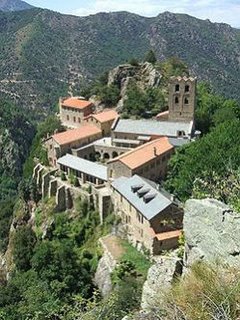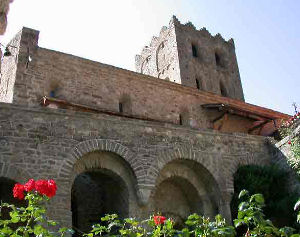Dracula , Whitby and the Black Death
Here's an interesting post for all you Dracula fans. Written by one of our Admin Team who recently came back from a trip to England's 'Dracula country'. He writes ....
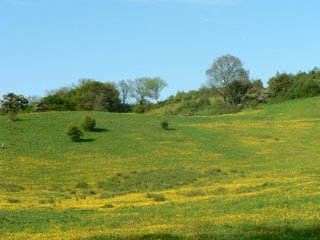 For the May Bank holiday we booked a week down in North Yorkshire, just outside the old harbour town of Whitby. Those of you who have read Bram Stoker's Dracula will of course immediately recognise the town!
For the May Bank holiday we booked a week down in North Yorkshire, just outside the old harbour town of Whitby. Those of you who have read Bram Stoker's Dracula will of course immediately recognise the town!
Anyway ... more about our trip.
We stayed in a small house in Iburndale, just below Sleights and maybe 4 miles from the harbour. Given the number of people who had descended upon Whitby this turned out to be a good idea. You can see from the picture the beautiful valley just round the corner from us. Buttercups covered the whole valley and most of the time we had it to ourselves.
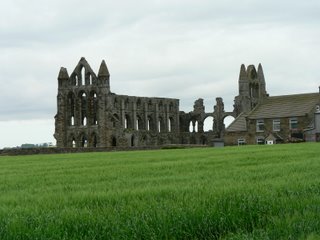 Now a little history. Whitby was really founded when the Abbey of Saint Hilda was built in 657 AD.You can see the Abbey up on the headland overlooking the harbour, dramatic indeed.
Now a little history. Whitby was really founded when the Abbey of Saint Hilda was built in 657 AD.You can see the Abbey up on the headland overlooking the harbour, dramatic indeed.
In 867 AD the Danes sacked the town and the Abbey was burnt to the ground.However it was rebuilt in 1078 AD as a Benedictine Priory and then all was relatively quiet until Henry VIII disolved the monasteries in 1539. Since then it has gradually deteriorated to the skeleton it now is. The Abbey is tied to the town as if by an umbilical cord. There are 199 stone steps leading down to Church Street (originally wooden steps) and it is this stairway which was used to carry the coffins up to the Abbey (note coffin rests and seats along the stairway).
Less well known to the general tourist but equally important for fans of Dracula is of course St Mary's Church. It dates back to 1110 AD and was built to help look after the workers at the Abbey.
So this is where Dracula comes in ... for Bram Stoker talks very evocatively of the dying sunlight striking the windows of the church and seeing Dracula's red eyes in the church windows.
Anyway we decided to walk the coastal path between Whitby and Robin Hood's Bay. Just 6 1/2 miles there and back.The weather was beautiful , the cliffs very dramatic and off we set.
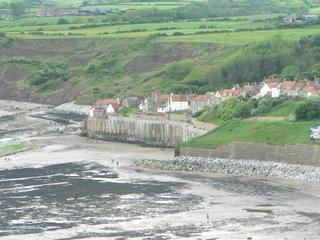 As we left Whitby and headed south a two masted schooner was plying its tourist trade around the bay. Ok a purist might say that the sails were furled and the ship was driven by diesel engines but if you half closed your eyes could it have been a century and more ago.
As we left Whitby and headed south a two masted schooner was plying its tourist trade around the bay. Ok a purist might say that the sails were furled and the ship was driven by diesel engines but if you half closed your eyes could it have been a century and more ago.
On the walk down to Robin Hood's bay I started to think why had Whitby been chosen? Was not Robin Hood's bay with it's dramatic sea defences more appropriate? Well, the answer was probably two-fold. On a practical level the chances are that in a smuggling village everyone knew each other so the chances of Dracula being unnoticed would be less .... and of course the Abbey and the graveyard were essential for Dracula.
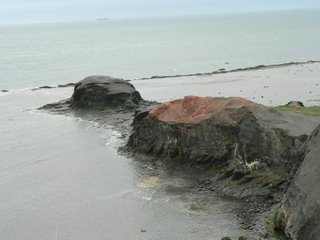 Coming back towards Whitby we were reminded that, although the sea was calm and serene just how dangerous it could be. Look at these rocks just outside the harbour. But as we approached the harbour again our thoughts went to another one many years earlier and many miles away. Sometime between June and December 1348 a sailor had landed from France, probably coming into Weymouth harbour and he brought with him the Black Death that swept north and left over 1/3rd of the population dead.
Coming back towards Whitby we were reminded that, although the sea was calm and serene just how dangerous it could be. Look at these rocks just outside the harbour. But as we approached the harbour again our thoughts went to another one many years earlier and many miles away. Sometime between June and December 1348 a sailor had landed from France, probably coming into Weymouth harbour and he brought with him the Black Death that swept north and left over 1/3rd of the population dead.
We will talk more about this later but for the moment we just knew that Dracula's arrival by sea wasn't the first time that terror had been brought to England.
Anyway ... more about our trip.
We stayed in a small house in Iburndale, just below Sleights and maybe 4 miles from the harbour. Given the number of people who had descended upon Whitby this turned out to be a good idea. You can see from the picture the beautiful valley just round the corner from us. Buttercups covered the whole valley and most of the time we had it to ourselves.
In 867 AD the Danes sacked the town and the Abbey was burnt to the ground.However it was rebuilt in 1078 AD as a Benedictine Priory and then all was relatively quiet until Henry VIII disolved the monasteries in 1539. Since then it has gradually deteriorated to the skeleton it now is. The Abbey is tied to the town as if by an umbilical cord. There are 199 stone steps leading down to Church Street (originally wooden steps) and it is this stairway which was used to carry the coffins up to the Abbey (note coffin rests and seats along the stairway).
Less well known to the general tourist but equally important for fans of Dracula is of course St Mary's Church. It dates back to 1110 AD and was built to help look after the workers at the Abbey.
So this is where Dracula comes in ... for Bram Stoker talks very evocatively of the dying sunlight striking the windows of the church and seeing Dracula's red eyes in the church windows.
Anyway we decided to walk the coastal path between Whitby and Robin Hood's Bay. Just 6 1/2 miles there and back.The weather was beautiful , the cliffs very dramatic and off we set.
On the walk down to Robin Hood's bay I started to think why had Whitby been chosen? Was not Robin Hood's bay with it's dramatic sea defences more appropriate? Well, the answer was probably two-fold. On a practical level the chances are that in a smuggling village everyone knew each other so the chances of Dracula being unnoticed would be less .... and of course the Abbey and the graveyard were essential for Dracula.
We will talk more about this later but for the moment we just knew that Dracula's arrival by sea wasn't the first time that terror had been brought to England.
Labels: Black Death, dracula, Whitby
